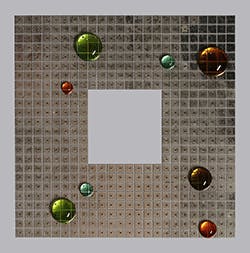MIT Discovery Could Drastically Reduce Experiment Costs
MIT researchers have developed hardware that uses electric fields to move droplets of chemical or biological solutions around a surface, mixing them in ways that could be used to test thousands of reactions in parallel.
MIT researchers develop hardware that uses electric fields to move droplets of chemical or biological solutions around a surface, mixing them in ways that could be used to test thousands of reactions in parallel. The researchers view their system as an alternative to the microfluidic devices now commonly used in biological research, in which biological solutions are pumped through microscopic channels connected by mechanical valves. The new approach, which moves solutions around in computationally prescribed patterns, could reportedly enable experiments to be conducted more efficiently, cost-effectively, and at larger scales.“Biology is moving toward more and more complex processes, and we need technologies to manipulate smaller- and smaller-volume droplets,” says Udayan Umapathi, a researcher at the MIT Media Lab, who led the development of the new system. “Pumps, valves and tubes quickly become complicated. In the machine that I built, it took me a week to assemble 100 connections. Let’s say you go from a scale of 100 connections to a machine with a million connections. You’re not going to be able to manually assemble that.”
With his new system, Umapathi explains, thousands of droplets could be deposited on the surface of his device, and they would automatically move around to carry out biological experiments. The system includes software that allows users to describe, at a high level of generality, the experiments they wish to conduct. The software then automatically calculates droplets’ paths across the surface and coordinates the timing of successive operations.
In the past 10 years, other research groups have experimented with “digital microfluidics,” or electrical manipulation of droplets, to conduct biological experiments. But their chips were manufactured using high-end etching techniques that require controlled environments known as clean rooms. Umapathi and his colleagues have focused on getting costs down. Their prototype uses a printed circuit board, a commodity electronic device that consists of a plastic board with copper wiring deposited on top of it.
Moving droplets requires high voltages, somewhere between 95 and 200 volts. But 300 times a second, a charged electrode in the MIT researchers’ device alternates between a high-voltage, low-frequency (1-kilohertz) signal and a 3.3-volt high-frequency (200-kilohertz) signal. The high-frequency signal enables the system to determine a droplet’s location, using essentially the same technology that touch-screen phones do. If the droplet isn’t moving rapidly enough, the system will automatically boost the voltage of the low-frequency signal. From the sensor signal, the system can also estimate a droplet’s volume, which, together with location information, allows it to track a reaction’s progress.
Umapathi believes that digital microfluidics could drastically cut the cost of experimental procedures common in industrial biology. Pharmaceutical companies, for instance, will frequently conduct many experiments in parallel, using robots equipped with dozens or even hundreds of pipettes, little measuring tubes that are rather like elongated eye droppers.
“If you look at drug discovery companies, one pipetting robot uses a million pipette tips in one week,” Umapathi says. “That is part of what is driving the cost of creating new drugs. I’m starting to develop some liquid assays that could reduce the number of pipetting operations 100-fold.”
Read the entire article here.



